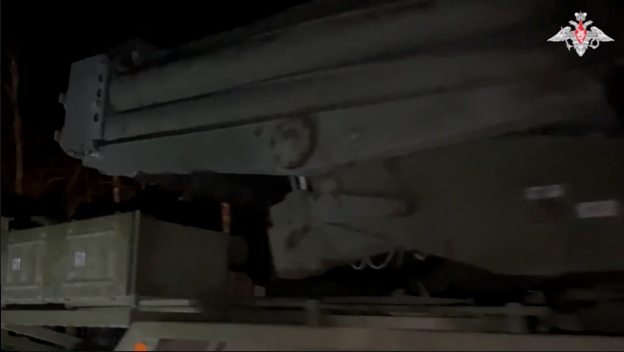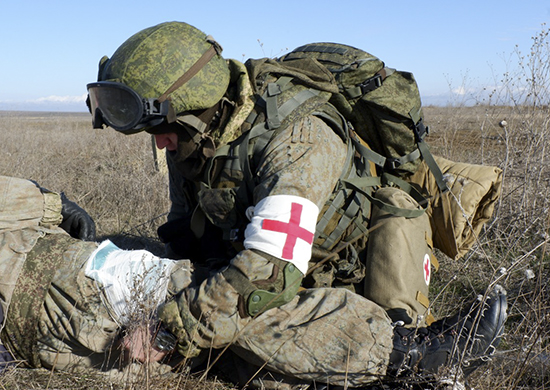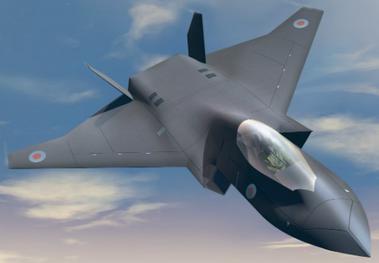
Still-frame from video of BM-27 Uragan MLRS supposedly moving into position to fire on Ukrainian targets near Belgorod, 16 April 2024.
“The Russian transition to the BAZ-69092 chassis seems to be motivated by several factors… but also aligns with Russian strategic preferences [necessity] for local production.”
Despite Western efforts to dismantle or limit its defense industry, Russia continues to find ways to produce the weapons it needs to fight its war in Ukraine.[i] As discussed in the excerpted article from the Azeri based Caliber news outlet, on 16 April, the Russian Ministry of Defense released a video unveiling an updated version of the BM-27 Uragan [R1] self-propelled multiple rocket launcher (MRL), supported by a new BAZ-69092 [R2] three axle chassis, at work in Ukraine.[ii] According to the Caliber article, the modifications are a reflection of not only the need to modernize Russia’s rocket and artillery systems, but also “align with Russian strategic [necessity] for local production.” The article notes that Russia has lost at least 83 BM-27 systems in Ukraine since it invaded in Feb 2022. Replacement of these and other systems is critical to Russia’s war effort. The article points out the original Uragan chassis were built in other parts of the former Soviet empire, including Ukraine.[iii] The new BAZ-96092 is a multi-platform chassis wholly built in Russia. Russia continues to rearm its military despite sanctions and restrictions imposed by the West to reduce Russia’s ability to fight the war in Ukraine.
OE Watch Insight:
Updated RUS Uragan MRLS appears on UKR battlefield demonstrating RUS ability to replenish its military systems despite western sanctions and restrictions intended to hold back military industrial establishment.
Sources:
“Russian Army deploys new version of BM-27 Uragan MLRS Rocket Launcher in Ukraine,” Caliber (Azeri based news source with good regional coverage from neighboring perspective), 18 April 2024. https://caliber.az/en/post/234544/
On April 16, 2024, the Russian Ministry of Defense released a video showing a night-time operation involving the BM-27 Uragan 220mm multiple launch rocket system (MLRS) near the Belgorod region. Notably, the video unveiled an updated version of the BM-27 Uragan launcher mounted on a new platform, identified as the BAZ-69092 three-axle chassis, marking a significant departure from its traditional ZIL-135LM 8×8 truck chassis.
The transition to the BAZ-69092 chassis is part of an ongoing modernization effort within the Russian Army to upgrade existing military equipment and improve its artillery capabilities. This strategy includes plans to replace the aging BM-27 Uragan MLRS with the more advanced Tornado-S [R1] system….
…
The Russian transition to the BAZ-69092 chassis seems to be motivated by several factors. Firstly, the Russian Army lost at least 83 units in Ukraine since the beginning of the conflict. As of 2023, the Russian Army had only 150 of these vehicles in service, indicating a critical need for the modernization and replacement of this valuable system. Secondly, Russian engineers could face difficulties in modernizing older vehicles such as the ZIL-135LM, whose production ceased in 1995. Thirdly, these difficulties need to be compared with the advantages offered by new platforms for improving combat efficiency. The adoption of the newer BAZ-69092 6×6 chassis offers several advantages, including its capacity to accommodate weapons systems weighing up to 13 tons, but also aligns with Russian strategic preferences for local production.
…It is interesting to note that the BAZ-69092 chassis was specifically developed to standardize and facilitate the use of various military and special vehicles within the Russian army. This initiative began in the early 1990s after the dissolution of the Soviet Union, which affected the supply of special chassis as key manufacturers were outside Russia (for instance MKZT in Belarus and KrAZ in Ukraine). The Bryansk Automobile Plant (BAZ) was tasked with developing the BAZ-69092 under the project code “Voshchina-1” to substitute for foreign-made chassis. The model is part of a family of vehicles designed for diverse functions, including combat and support roles, tailored to meet specific requirements of the military.
Notes:
[i] For recent media reporting on Russia’s resurgent domestic arms industry, see: “Russia ramps up weapons production, using mass quantity to outgun Ukraine,” The Washington Post, 19 April 2024. https://www.washingtonpost.com/world/2024/04/19/russia-weapons-production-ukraine-war/; Russia has also received Chinese and Iranian weapons assistance. For recent news coverage regarding Chinese assistance, see: “China Has Helped Russia Boost Arms Production, U.S. Says,” The Wall Street Journal, 12 April 2024. https://www.wsj.com/politics/national-security/china-russia-arms-production-help-c098c08b and “US intelligence finding shows China surging equipment sales to Russia to help war effort in Ukraine,” The Associated Press, 19 April 2024. https://apnews.com/article/united-states-china-russia-ukraine-war-265df843be030b7183c95b6f3afca8ec
[ii] Fielding of the new and improved Russian BM-27 had been anticipated for months. See: Російські БМ-27 “Ураган” отримали нове шасі БАЗ-69092 (Russia Modernizes BM-27 Uragan Rocket Launchers with BAZ-69092 Chassis Upgrade),” Militarnyi (Ukraine media outlet focused on the military and defense industry), 22 December 2023. https://mil.in.ua/uk/news/rosijski-bm-27-uragan-otrymaly-nove-shasi-baz-69092/
[iii] The above sourced Caliber article noted that Ukraine is also “modernizing its BM-27 MLRS, fitting the Uragan launcher on a Tatra Т815-7Т3RC1 chassis, resulting in the creation of the Bureviy system. Revealed in 2020 and developed by the Shepetiv Repair Plant, the Bureviy successfully completed fire tests in November 2020. Ukraine also developed the Bastion-03, which combines a KrAZ-6322 chassis with a 9K57 Uragan MLRS launcher. This latter project is part of a Ukrainian initiative to standardize rocket artillery chassis using the KrAZ platform, following the earlier Bastion-01 and Bastion-02 models.”
Image Information:
Image: Still-frame from video of BM-27 Uragan MLRS supposedly moving into position to fire on Ukrainian targets near Belgorod, 16 April 2024.
Source: Russian Ministry of Defence, https://t.me/mod_russia/37664
Attribution: Public Domain


